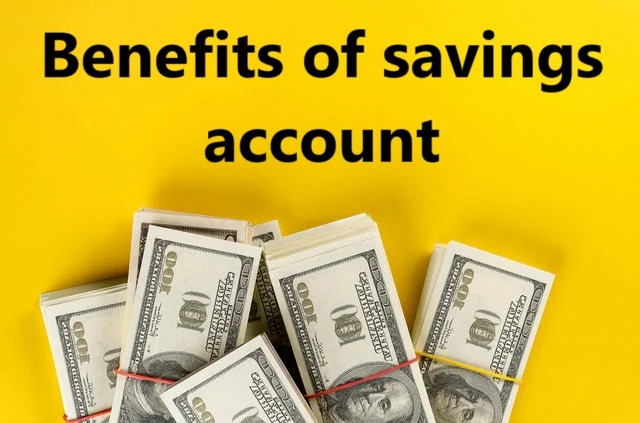Benefits of Savings Account and Savings Account Example
Key Insights on High-Yield Savings Accounts:
70% of Americans do not have a savings account with a sufficient balance ($11,000 or more).
Only 7% of people with savings accounts actually have a high-yield savings account.
23% of people with savings accounts receive a mere 0.5% interest rate, losing out on potential earnings.
Why You Need a High-Yield Savings Account:
Higher Interest Rates: Traditional savings accounts offer between 0.01% and 0.05%. High-yield savings accounts offer between 3% and 5.5% interest, significantly increasing your returns.
Liquidity: Unlike retirement accounts that may impose penalties, high-yield savings accounts provide immediate access to your money.
No or Low Fees: Most high-yield savings accounts come with little to no monthly fees and don’t require a high minimum balance, making them accessible and cost-effective.
Real-Life Comparison:
- Regular Savings: If you had $115,000 in a standard savings account, you would earn $7.50 in interest annually.
- High-Yield Savings: The same $115,000 in a high-yield account earning 5% would yield $750 annually—an enormous difference!
Top 5 High-Yield Savings Accounts (2024 Update):
- Basque Bank: 5% APY, no minimum balance, FDIC insured.
- Citi Bank: 5.05% APY, requires a $5,000 minimum balance.
- Laurel Road Bank: 5% APY, no minimum balance, zero monthly fees, FDIC insured.
- Virtual Bank: 5% APY, no minimum balance, FDIC insured.
- Bank Purely: 5.05% APY, requires a $25,000 minimum balance, great for holding emergency funds.
Things to Consider:
- Withdrawal Limits: Some high-yield savings accounts, like Bank Purely, restrict the number of monthly withdrawals. You may need to call the bank to increase withdrawal limits if you need access to large sums.
- Transfer Speed: Transfers from high-yield savings accounts can take a few hours to a day, unlike instant transfers from regular savings accounts.
By having a high-yield savings account, you can let your emergency fund or other savings grow while maintaining liquidity for when you need it.
Benefits:
Guaranteed Security with FDIC Insurance
Savings accounts offer a unique level of security with FDIC insurance covering up to $250,000 per depositor. This means that even if your bank fails, your money remains safe and accessible. Unlike volatile investments like stocks, bonds, or cryptocurrencies that can result in total losses, savings accounts ensure your funds are protected from market fluctuations and business failures. This protection provides peace of mind, making savings accounts a safe choice for those who prioritize financial security.
Secure and Steady Growth
Savings accounts offer a safe and reliable way to grow your money without the risk of losing it. Unlike other investment options, your savings account balance won’t dip unless you withdraw from it. Instead, it continues to grow, making it a stable choice during volatile times.
For instance, in 2008, when the stock market dropped nearly 40%, savings accounts maintained their value and even saw slight growth. If safeguarding your money from loss is a priority, a savings account provides peace of mind, unlike riskier investments like stocks or real estate.
Immediate Access to Your Savings
One of the key benefits of a savings account is the ability to access your money instantly. Whether through an ATM or a debit card, your funds are always within reach, making savings accounts ideal for emergencies.
In contrast, liquidating other investments can take time, sometimes days or even months. Real estate, for example, may require months to sell. This convenience makes savings accounts a preferred option for emergency funds—always available when needed. However, keep in mind that federal regulations may limit the number of withdrawals to six per month, with potential fees for exceeding this limit.
Steady, Modest Returns
While savings accounts won’t make you rich, they do provide consistent, small returns. As of September 2023, the national average interest rate for savings accounts was 0.45%, with some major banks offering as low as 0.01%, according to FDIC data.
Though these returns are modest compared to the stock market, they’re reliable. Your money earns interest steadily, offering more security than leaving cash idle. Some accounts, like Capital One’s 360 Performance Savings (4.3%) and SoFi (4.5%), offer higher returns, making it worthwhile to research options with better rates.
Accessible Investment Options
Savings accounts offer a low barrier to entry compared to other investments like real estate or mutual funds, which often require a significant initial investment. Most savings accounts have minimal or no balance requirements, allowing you to deposit any amount and start saving.
While you may not amass wealth quickly, your funds remain secure. Savings accounts are ideal for money you can’t afford to lose, providing a reliable option for emergency funds and serving as a safety net against more volatile investments.
Though they may lack the excitement of higher-yielding options, savings accounts are a crucial component of a well-rounded financial strategy. Don’t underestimate their value in your financial planning.
Savings Account Example: Lessons I Learned from My High-Yield Savings Account
When I first signed up for my high-yield savings account (HYSA), I didn’t know what to expect. Over time, I learned three key lessons that I’ll share today. These tips will better prepare you for opening your high-yield savings account, compared to where I was five years ago.
1. Be Prepared for Taxes
If you open a high-yield savings account, you’re likely going to receive a 1099-INT form. This form details the interest income you’ve earned over the year. At my previous bank, I didn’t earn much interest—around 0.01% to 0.05%. Therefore, I never received a 1099-INT because I didn’t earn enough interest.
However, after transitioning to a high-yield savings account, I started receiving these forms annually. Remember, if you earn $10 or more in interest, you’ll receive this form.
Although paying taxes on interest may not seem exciting, earning interest is still a positive thing—it’s money you wouldn’t have otherwise gained without an HYSA. Keep in mind that taxes are part of building wealth, and your high-yield savings account isn’t exempt. As you watch your account grow, set aside some money for taxes in case you owe during tax season.
2. Don’t Limit Yourself to One Savings Account
You don’t have to stick to just one high-yield savings account. If you come across different offers from banks, you can open multiple accounts and enjoy the perks from each. For example, some banks offer bonuses like $250 or $100 for signing up, so why not take advantage of these offers? Just make sure you understand the requirements for earning these bonuses.
By trying out different accounts, you can decide which ones you prefer, and you won’t feel locked into a single bank.
3. Interest Rates Are Not Permanent
One of the most important lessons is that interest rates on high-yield savings accounts fluctuate over time. The 4-5% APY you see today won’t be the same a year from now, or even a few months from now.
This is why I choose not to rely on my HYSA interest as a consistent income. Eventually, rates will drop, so it’s crucial not to tie yourself to any financial obligations based on your HYSA earnings.
If you’re currently trying to achieve financial independence or get out of financial trouble, this lesson is especially important. Don’t count on high APY rates staying constant.
FAQ
What is the benefit of a high-yield savings account?
High-yield savings accounts offer higher interest rates (3%-5.5%) compared to traditional savings, maximizing your returns.
Are high-yield savings accounts safe?
Yes, they are FDIC insured, protecting up to $250,000 per depositor, ensuring your money is secure.
How often can I withdraw from a high-yield savings account?
Some accounts limit withdrawals to six times per month due to federal regulations, but you can increase this by contacting your bank.
Do high-yield savings accounts have fees?
Most high-yield savings accounts have little to no fees and don’t require high minimum balances, making them cost-effective.







Doubt: “Are high-yield savings accounts safe? How do they ensure better interest rates without risking security?”
“High-yield accounts are typically offered by reputable institutions, insured by the FDIC, ensuring security while maximizing returns.”
“Consider diversifying your savings strategy with a high-yield account to maximize earnings and secure financial stability.”
Doubt: What about the potential risks or fees associated with high-yield savings accounts? Are they secure?
Author’s Reply: High-yield savings accounts are typically FDIC-insured, offering security, though it’s important to research any potential
Having a high-yield savings account helped me grow my emergency fund faster with higher interest rates.
Doubt: What are the risks associated with high-yield savings accounts? How do they compare to traditional ones?
Reply: High-yield accounts may have stricter terms or fees. Comparison shows high-yield provides better returns despite some limitations.
Comment: Can you explain how high-yield savings accounts are different from traditional accounts?
Reply: High-yield savings accounts offer much higher interest rates than traditional accounts, helping you grow your savings faster.
Good insights on the benefits of high-yield savings accounts. Include tips on optimizing savings for broader appeal & clarity.
Comment: Isn’t there a risk with high-yield savings accounts? What about the safety of the institution and fluctuations?
Author Reply: High-yield savings accounts are typically offered by reputable banks and are FDIC insured for up to $250,000
Doubt: “Are there any risks associated with high-yield savings accounts that we should be aware of?”
Author Reply: “High-yield savings accounts may have minimum balance requirements or withdrawal restrictions, so it’s important to check terms.”
Critique: More detailed examples of recommended high-yield savings account options or comparisons could enhance the post’s credibility and relevance.
Critique: The post lacks detailed examples of high-yield savings account options, making it less informative for readers seeking specific recommendations.
“I opened a high-yield savings account and earned more interest in a month than my traditional account all year.”
Comment: “What are the risks associated with high-yield savings accounts that offer such high interest rates?”
Reply: “High-yield savings accounts may have withdrawal restrictions or require minimum balances, but these can often be manageable.”